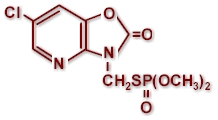Azamethiphos is an antiparasitic active ingredient used in livestock premises against flies, also against salmon lice. It is not used against agricultural and household pests. It belongs to the chemical class of the organophosphates.
Common name: AZAMETHIPHOS
Type: Pesticide, biocide
Chemical class: organophosphate
CHEMICAL STRUCTURE

EFFICACY AGAINST PARASITES
Type of action: non-systemic contact and oral insecticide
Main veterinary parasites controlled: houseflies and other nuisance flies
Efficacy against a specific parasite depends on the delivery form and on the dose administered. National regulatory authorities determine whether a product is approved for a given indication, i.e. use on a particular host at a specific dose and against a specific parasite. Check the labels of the products available in your country.
Click here for general information on features and characteristics of PARASITICIDES.
SAFETY
Oral LD50, rat, acute*: 1180 mg/kg
Dermal LD50, rat, acute*: >2150 mg/kg
* These values refer to the active ingredient. Toxicity has to be determined for each formulation as well. Formulations are usually significantly less toxic than the active ingredients.
MRL (maximum residue limit): Not applicable: not approved for livestock
Withholding periods for meat, milk, eggs: Not applicable: not approved for livestock
|
WARNING Never use agricultural or hygiene products with this or any other active ingredient on livestock or pets, even if there are veterinary products with this same active ingredient approved for use on animals. The formulations for agricultural or hygiene use are different and may be toxic for livestock or pets. It is obvious that veterinary products are not intended for and should never be used on humans!!> |
MARKETING & USAGE
Decade of introduction: 1970
Introduced by: CIBA-GEIGY
Some original brands: ALFACRON, SNIP
Patent: Expired (Particular formulations may be still patent-protected)
Use on LIVESTOCK: No, only for off-animal use
Use on DOGS and CATS: No
Main delivery forms:
Use in human medicine: No
Use in public/domestic hygiene: No
Use in agriculture: No
Generics available: Yes, a few
PARASITE RESISTANCE
On livestock: Yes, worldwide, reported on houseflies (Musca domestica) to all organophosphates.
Visit also the section in this site about parasite resistance to antiparasitics and more specifically to organophosphates.
SPECIFIC FEATURES
Azamethiphos is a veteran organophosphates used almost exclusively for the off-animal control of houseflies and nuisance flies aas well as crawling insects in livestock operations: stables, dairy premises, piggeries, poultry houses, etc.
On is available in the form of ready-to-use baits (e.g. scatter baits) or in concentrates for premise and environmental treatment.
The original manufacturer (Ciba-Geigy → Novartis) sold the azamethiphos business (incl. the registered trademarks) in 2003, when it decided for strategic and image reasons to get rid of all organophosphates. Azamethiphos products are still available in a few countries from other manufacturers. Novartis replaced its azamethiphos product line with comparable products containing thiamethoxam, a newer neonicotinoid pesticide.
Efficacy of azamethiphos
Azamethiphos is highly effective against susceptible houseflies and it kills them very quickly. It acts mostly by oral ingestion. This means that the contact (or tarsal) effect is usually insufficient against bloodsucking flies (e.g. stable flies or horn flies, etc.).
Interestingly, azamethiphos as a bait shows an excellent efficacy against certain housefly populations resistant to other organophosphates (e.g. diazinon, dichlorvos, etc.) and carbamates (methomyl, etc.). However, there are also housefly strains that are specifically resistant to azamethiphos, apparently because they simply avoid the sugar in the scatter baits or added to the concentrates to increase its attractiveness for houseflies.
It also has efficacy against some poultry mites, cockroaches and other crawling pests, but it is usually insufficient to control serious infestations.
Azamethiphos is also used as a lousicide in fish farms, especially against salmon lice.
However, resistance of houseflies and other pests to all organophosphates, including azamethiphos is widespread. As a consequence, products with this active ingredient may not achieve the expected efficacy in many places. The same applies to all other organophosphates. This is also a reason for their progressive replacement with newer active ingredients with a different mode of action.
Pharmacokinetics of azamethiphos
Azamethiphos is not intended for on-animal use. Azamethiphos is poorly absorbed through the skin. Following oral administration to rats azamethiphos is well absorbed to the bloodstream. Part of the administered dose is hydrolyzed to various metabolites. Most of the administered dose is excreted through urine.
Mechanism of action of azamethiphos
As all organophosphates insecticides, azamethiphos acts on the nervous system of the parasites (but also of mammals, birds, fish and many organisms!) as inhibitor of acetylcholinesterase (also known as AchE), an enzyme that hydrolyzes acetylcholine (Ach). Ach is a molecule involved in the transmission of nervous signals from nerves to muscles (so-called neuromuscular junctions) and between neurons in the brain (so-called cholinergic brain synapses).
AchE's role is to terminate the transmission of nervous signals where Ach is the neurotransmitter (there are several other neurotrasmitters). By inhibiting the activity of AchE, organophosphates prevent the termination of those nervous signals, i.e. the neurons remain in constant activity and excitation, massively disturbing the normal movements of the parasites. The bottom line for the parasites is that they are paralyzed and die more or less quickly. Organophosphates bind irreversibly to AchE, in contrast with carbamates, another chemical class of parasiticides, which bind reversibly to AchE.
Click here to view the list of all technical summaries of antiparasitic active ingredients in this site.